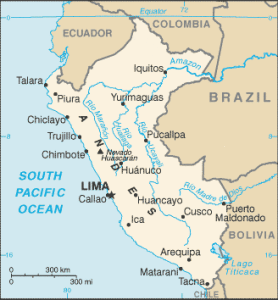Peru
Fast Facts
Official Name: Republic of Peru
Form of Government: Constitutional republic
Capital: Lima
Population: 30,147,935
Official Languages: Spanish, Quechua
Money: Nuevo Sol
Area: 496,224 square miles (1,285,216 sqare kilometers)
Major Mountain Ranges: Andes
Major Rivers: Amazon, Ucayali, Madre de Dios
What You Should Know
Ancient Peru was the seat of several prominent Andean civilizations, most notably that of the Incas whose empire was captured by Spanish conquistadors in 1533. Peru declared its independence in 1821, and remaining Spanish forces were defeated in 1824. After a dozen years of military rule, Peru returned to democratic leadership in 1980, but experienced economic problems and the growth of a violent insurgency. President Alberto FUJIMORI's election in 1990 ushered in a decade that saw a dramatic turnaround in the economy and significant progress in curtailing guerrilla activity. Nevertheless, the president's increasing reliance on authoritarian measures and an economic slump in the late 1990s generated mounting dissatisfaction with his regime, which led to his resignation in 2000. A caretaker government oversaw a new election in the spring of 2001, which installed Alejandro TOLEDO Manrique as the new head of government – Peru's first democratically elected president of indigenous ethnicity. The presidential election of 2006 saw the return of Alan GARCIA Perez who, after a disappointing presidential term from 1985 to 1990, oversaw a robust economic rebound. Former army officer Ollanta HUMALA Tasso was elected president in June 2011, and carried on the sound, market-oriented economic policies of the three preceding administrations. Poverty and unemployment levels have fallen dramatically in the last decade, and today Peru boasts one of the best performing economies in Latin America. Pedro Pablo KUCZYNSKI Godard won a very narrow presidential runoff election in June 2016.
Geography
Peru is the third largest country in South America, after Braziland Argentina. It is made up of a variety of landscapes, from mountains and beaches to deserts and rain forests. Most people live along the coast of the Pacific Ocean, where the capital, Lima, is located.
Along Peru's west coast is a narrow strip of desert 1,555 miles (2,500 kilometers) long. Ancient people, called the Chimú and the Nasca, first inhabited this region thousands of years ago. The coastal desert makes up only about 10 percent of Peru, but it is home to more than half of all Peruvians.
The world's largest rain forest, the Amazon, covers nearly half of Peru. Called the selva in Spanish, this huge jungle, which also covers half of Brazil, is home to plants and animals that do not live anywhere else on Earth. Some scientists think there may even be Indian tribes there that have never seen the outside world.
The second highest mountain range in the world runs through Peru. These peaks, called the Andes, are so tall and forbidding that the ancient Inca people thought they were gods. They run from north to south and can be seen from Peru's beaches 50 miles (80 kilometers) to the west. The highest peak, Mount Huascarán, is 22,205 feet (6,768 meters) high.
Climate
Although Peru's seaboard is situated well within the tropical zone, it does not display an equatorial climate; average temperatures range from 21°c (70°f) in January to 10°c (50°f) in June at Lima, on the coast. At Cuzco, in the sierra, the range is only from 12°c (54°f) to 9°c (48°f), while at Iquitos, in the Amazon region, the temperature averages about 32°c (90°f) all year round. The cold south–north Humboldt (or Peruvian) Current cools the ocean breezes, producing a sea mist with the inshore winds on the coastal plain. Only during the winter, from May to October, does this sea mist (garúa) condense into about 5 cm (2 in) of rain.
Latitude has less effect upon the climate of the sierra than altitude. The rainy season in the Andes extends from October to April, the reverse of the coastal climate. Temperatures vary more from day to night than seasonally. The snow line ranges from 4,700 to 5,800 m (15,500 to 19,000 ft). In the eastern rain forest, precipitation is heavy, from 190 to 320 cm (75 to 125 in) annually; rain falls almost continuously between October and April.
A warm Pacific west-to-east current called El Niño appears near the Peruvian coast every four to ten years around Christmastime (the name is a reference to the Christ child), occasionally causing serious weather disturbances.
Nature
Because it has so many different ecosystems, Peru is home to a wider variety of plants and animals than most other countries on Earth. For many reasons, Peruvians have not had as much of an impact on their natural world as many other countries, and much of these ecosystems have been undisturbed.
A 250-acre (100-hectare) plot of Peruvian rain forest is home to more than 6,000 kinds of plants! There are hundreds of species that are only found in the Amazon. To protect these plants and animals, Peru has created special forest areas called reserves.
On the Pacific Coast, many interesting plant and animal species have adapted to the dry desert climate. And off the coast, the Peru Current nourishes huge numbers of small fish, which in turn support large populations of bigger fish and seabirds, including Humboldt penguins.
Peru's mountains support special types of grasses and plants, which provide food for mammals like llamas, alpacas, and vicuñas. One plant that grows in the Andes, the puya raimondi, grows for a hundred years before blooming.




